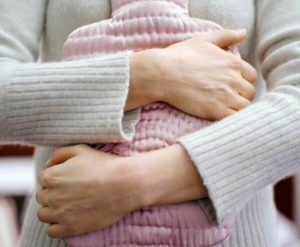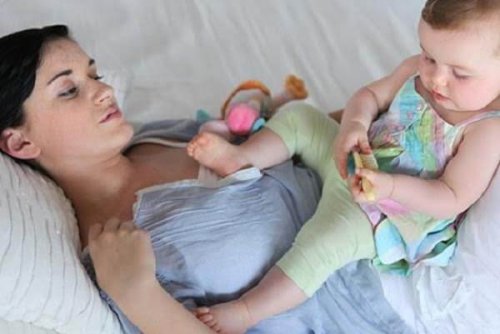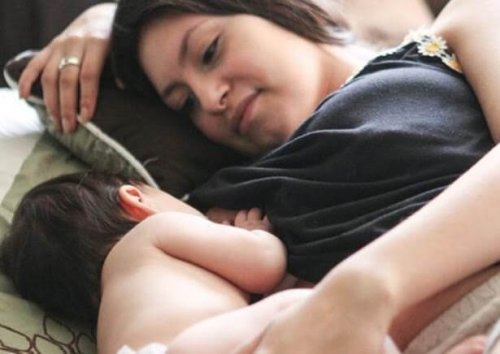Postpartum Menstruation: What You Need to Know

Once your baby is born, your body will slowly begin the process of going back to normal and you’ll eventually get your period again. If you’re wondering about postpartum menstruation, here’s what you need to know.
Nine months of pregnancy have already gone by. You have your little one right before you, tucked comfortably in your loving arms. And surely you’ve asked yourself how much time will go by before you start to menstruate again.
Your body begins to recover from the arduous process of pregnancy and birth. Your organs are still trying to return to their original locations. Your body is focused on producing breast milk for your little one.
Your neuro-endocrine system is responsible for making your period appear for the first time, usually during adolescence. In the same way, women relive this experience after pregnancy when their body is ready.
That being said, a factor that has a considerable influence on the return of menstruation is breastfeeding.
For six to eight weeks after birth, your body sheds the so-called postpartum lochia. Lochia refers to vaginal secretions containing blood, mucus and uterine tissue.
Once the lochia is expelled, your first postpartum menstruation can appear within just a few weeks if you haven’t breastfed. However, if you are nursing your baby, your period can take up to 2 years to return.
Postpartum menstruation: What you need to know

According to the World Health Organization, most women who do not nurse their little ones go back to menstruating just four months after their babies are born. In most cases, women who are not lactating begin to have normal ovarian activity within 30 days.
The symptoms you have when you begin menstruating again may vary. And they might be very different from the symptoms you experienced before pregnancy.
Your menstrual flow may be altered, given that certain imbalances are normal during your first postpartum cycles. However, other symptoms may vary as well from your previous experiences.
Postpartum menstruation can be accompanied by ovulation
Menstruation and breastfeeding

Have you ever asked yourself why mothers who breastfeed often do not get their periods? The answer has to do with chemistry. When a baby suckles his mother’s breast, the mom’s body automatically produces the hormone prolactin. The famous prolactin hormone has the power to inhibit the functioning of the ovaries.
In this sense, breastfeeding is considered a method of natural contraception. It is also known as the Lactation and Amenorrhea Method (LAM). But… Be careful! Don’t trust in this method alone. It is not 100% effective and you could easily end up with another little one on the way.
When your baby begins a complementary diet, this may bring on the return of your menstruation.
Nature is amazing. Somehow, your body knows that you are dedicated to the task of nursing. So, your body protects you in the meantime from another pregnancy.
However, its effectiveness is only 98%, and only under certain conditions. Breastfeeding needs to be completely or almost completely exclusive (no foods or formulas) and the baby needs to nurse at least once every 6 hours. Also, your baby should be younger than 6 months.
Generally, when babies start eating, aside from breastfeeding, you will experience your first period. This is due to the fact that your baby will start to nurse less frequently and your prolactin levels will go down. However, some moms continue to experience amenorrhea until their babies stop nursing altogether.
Your own body’s dynamics will determine the precise moment to return to the routine of menstruation. What’s important is that you’re healthy and that your baby is getting the nourishment he needs. And of course, that you and your baby enjoy this beautiful encounter.
Once your baby is born, your body will slowly begin the process of going back to normal and you’ll eventually get your period again. If you’re wondering about postpartum menstruation, here’s what you need to know.
Nine months of pregnancy have already gone by. You have your little one right before you, tucked comfortably in your loving arms. And surely you’ve asked yourself how much time will go by before you start to menstruate again.
Your body begins to recover from the arduous process of pregnancy and birth. Your organs are still trying to return to their original locations. Your body is focused on producing breast milk for your little one.
Your neuro-endocrine system is responsible for making your period appear for the first time, usually during adolescence. In the same way, women relive this experience after pregnancy when their body is ready.
That being said, a factor that has a considerable influence on the return of menstruation is breastfeeding.
For six to eight weeks after birth, your body sheds the so-called postpartum lochia. Lochia refers to vaginal secretions containing blood, mucus and uterine tissue.
Once the lochia is expelled, your first postpartum menstruation can appear within just a few weeks if you haven’t breastfed. However, if you are nursing your baby, your period can take up to 2 years to return.
Postpartum menstruation: What you need to know

According to the World Health Organization, most women who do not nurse their little ones go back to menstruating just four months after their babies are born. In most cases, women who are not lactating begin to have normal ovarian activity within 30 days.
The symptoms you have when you begin menstruating again may vary. And they might be very different from the symptoms you experienced before pregnancy.
Your menstrual flow may be altered, given that certain imbalances are normal during your first postpartum cycles. However, other symptoms may vary as well from your previous experiences.
Postpartum menstruation can be accompanied by ovulation
Menstruation and breastfeeding

Have you ever asked yourself why mothers who breastfeed often do not get their periods? The answer has to do with chemistry. When a baby suckles his mother’s breast, the mom’s body automatically produces the hormone prolactin. The famous prolactin hormone has the power to inhibit the functioning of the ovaries.
In this sense, breastfeeding is considered a method of natural contraception. It is also known as the Lactation and Amenorrhea Method (LAM). But… Be careful! Don’t trust in this method alone. It is not 100% effective and you could easily end up with another little one on the way.
When your baby begins a complementary diet, this may bring on the return of your menstruation.
Nature is amazing. Somehow, your body knows that you are dedicated to the task of nursing. So, your body protects you in the meantime from another pregnancy.
However, its effectiveness is only 98%, and only under certain conditions. Breastfeeding needs to be completely or almost completely exclusive (no foods or formulas) and the baby needs to nurse at least once every 6 hours. Also, your baby should be younger than 6 months.
Generally, when babies start eating, aside from breastfeeding, you will experience your first period. This is due to the fact that your baby will start to nurse less frequently and your prolactin levels will go down. However, some moms continue to experience amenorrhea until their babies stop nursing altogether.
Your own body’s dynamics will determine the precise moment to return to the routine of menstruation. What’s important is that you’re healthy and that your baby is getting the nourishment he needs. And of course, that you and your baby enjoy this beautiful encounter.
All cited sources were thoroughly reviewed by our team to ensure their quality, reliability, currency, and validity. The bibliography of this article was considered reliable and of academic or scientific accuracy.
- Fabre González E. Manual de asistencia al parto y puerperio normal. INO Reproducciones S.A., Zaragoza, 1995.
- Willians CE, 20ª edición. Anormalidades del puerperio. 1998. 499-510.
- Atención posparto a madres y recién nacidos. Puntos destacados de las pautas de la Organización Mundial de la Salud para 2013. [En línea] Disponible en: https://www.mcsprogram.org/wp-content/uploads/2016/03/WHO-PNC-2014-Briefer-A4-SP.pdf
This text is provided for informational purposes only and does not replace consultation with a professional. If in doubt, consult your specialist.








